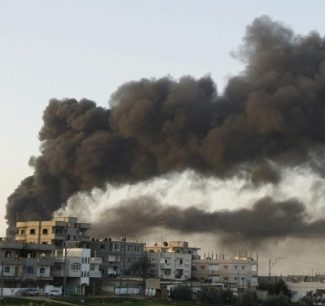The disintegration of the Soviet Union in the 1980s heralded the end of the Cold war. Many regarded this as the beginnings of an age of peaceful American-led world order, where there would be no more Soviet evil to fight. President H.W. Bush’s New World Order speech made to the United States Congress at the end of the 1991 Gulf War revealed the disposition of the American policymaking community of the time. Israel is mentioned seven times in the speech, which reveals the enduring strategic friendship between both democracies and signals to both the Palestinians and Israelis the need to recognize each other’s legitimate political rights. The success of the Gulf War coalition (which included Arab monarchies of the neighborhood) and the international praise Israel received for the incredible restraint it showed by not retaliating against Saddam’s Scud strikes suggested that the time was ripe for negotiations and compromise.
The Birth of the Oslo Process
Many Israelis, then Prime Minister Yitzhak Shamir included, believed that the land-for-peace agreement as decided by UN Resolution 242 was flawed. They opined that peace would remain elusive as long as the Arabs did not recognize Israel’s right to exist. The slow process that followed frustrated Israeli officials and hence the need for direct negotiations with Arafat and the PLO was deemed inevitable. This led to the beginnings of the Oslo peace process that started with PLO-Israel mutual recognition in 1993, the peace treaty with Jordan in 1995 and the failure of the Camp David Summit in 2000 that led to the second Intifada.
The Palestinians’ demands were manifold. They sought an Israeli withdrawal from the Occupied Territories (both in terms of military presence as well as settlers), the founding of the state of Palestine with Jerusalem as its capital, and an end to the refugee crisis in exchange for recognition of Israel’s right to exist. The Israeli offer in favor of forming a Palestinian interim self-government in the Occupied Territories (whereby power will be gradually restored to the Palestinians) was well-received. Issues that were regarded as related to “final status” were to be resolved at a later stage of the peace process. These “final status” issues included the refugees’ right to return and the status of Jerusalem.
Yet many other issues were left unaddressed in the peace accords. Ironically, nowhere in the agreements is a timeframe mentioned for the end of Israel’s occupation of the territories. The documents merely talk about establishing an interim self-government and the “gradual” transfer of power. But when power was indeed transferred, the Israeli government ensured that a Palestinian state would not be established by placing significant restrictions on Palestinians and the Palestinian Authority, moves that were supported by the United States. A Congressional Research Service document covering the amount of aid money that Washington gives the Middle East outlines several restrictions placed on the amount Palestinians can receive annually. Two out of the six statements (one regarding a ban on US assistance to Palestinians in matters of statehood and the other a ban on assistance to the Palestinian Broadcasting Corporation) clearly state that the aid restrictions are based on the need to protect Israel and its citizens. Therefore, while the “democratically elected” Palestinian Authority exists, its survival and claims to sovereignty over Palestinian lands are at the mercy of Israel and the United States. The democratically-elected government of West Bank is, ironically, not directly answerable to the citizens of West Bank, but to the occupier state of Israel. This comes as a direct result of the flawed terms of the Oslo Accords.
The Impact of Oslo
The Oslo peace process is widely regarded as a failure, but in many ways the signing of the accords set the tone for future negotiations between the two sides. The PLO’s recognition of the State of Israel set in motion a series of events in the Arab world regarding improving relations with Israel, which would have been unthinkable a couple of years before. Yet the dissenting voices were many. This included (most importantly) right-wing leaders in Israel as well as Palestine. Several efforts were made to portray the Oslo process in bad light. While Hamas’s al- Qassam brigades openly challenged PLO’s recognition of Israel and committed terror attacks, the murder of Yitzhak Rabin by a Jewish right-wing fanatic and growing domestic support for Likud leader Benjamin Netanyahu also crippled the process to a great extent.
The biggest obstacle the Oslo process faced was the difficulty of obtaining a domestic consensus regarding issues that would contribute to lasting peace in the region. Many leaders and prominent actors on both sides failed (or were unwilling) to appreciate the symbolic value of the accords in mutual trust-building. Instead, deep levels of mistrust about the intentions of the “Palestinian terrorists” resulted in Israeli opponents of the process frowning at even the slightest Palestinian violation of the accords, such as failing to arrest radical elements in Palestinian society. At the same time, Israel continued with its settlement building in sensitive areas of the city of Jerusalem. Every such violation by the other resulted in a hue and cry by the opposition about the trustworthiness of the other and hence the negotiators found it hard to maneuver because of these very domestic constraints.
The Process Unravels
While Arafat’s outright rejection of Israel’s proposals at Camp David and the subsequent resumption of terror attacks by the Arabs is given wide coverage as the main reason for the failure of the Oslo process, issues like that of refugees as well as settlements in the West Bank also played a major role in derailing peace talks. According to the accords, West Bank was divided into three parts: Areas A, B and C. Area A would be under exclusive PA authority. Area B would constitute scattered settlements with greater level of Israeli control and Area C, which would be under total Israeli control. This statement hides the fact that Area A constitutes merely two percent of the total area of West Bank while Area B constitutes nearly twenty-five percent of total land in scattered settlements, leaving almost seventy percent of the remaining territory under exclusive Israeli control. It should also be noted that Area C is home to significant amounts of mineral wealth, especially around the Dead Sea region. The area is also a major tourist hotspot, thereby generating high revenues for the businesses that thrive there. But the most important resources in the region are arable land and the presence of water for irrigation. Therefore, Israel has the ability to divert water at their sources towards Israeli settlements, thus depriving Palestinians of drinking water. Since most parts of Areas A and B are scattered settlements and Area C surrounds these settlements almost entirely, the former areas are economically and politically strangulated. Such a policy would also, indirectly, deprive any future Palestinian state of geographic continuity, stalling the formation of a viable state.
In hindsight, we see that the terms of the Oslo accords that divided West bank territories into Areas A, b and C have resulted in a situation where peace seems evermore distant. Settlers to the Occupied Territories are provided subsidies and tax benefits. The municipal councils in the West bank area like the Yesha Council hardly represent Palestinian interests and continue to report increasing influx of settlers. Simultaneously, the Israeli government has also slowed down the allotment of building permits to Palestinian civilians in the area and has repeatedly resorted to demolishing Palestinian houses. The peace accords also institutionalized restrictions placed on the movement of people and goods in the Occupied Territories. This crippled the economy and living standards of the Palestinians. Soaring poverty and unemployment rates coupled with the increasing influx of settlers this fueled anger and resentment against the Israeli government, which negatively impacted the peace process.
It is also true that the Palestinian leadership were somewhat to blame for their acquiescence to the institutionalization of terms in the Oslo process that converted Gaza and most areas of West bank into an open air prison. The very fact that both parties sought a bilateral solution to the dispute rather than through instruments of international law, by virtue of which Israel’s occupation of Palestinian territories was unequivocally illegal, defies common logic. The peace accords were essentially made by Israelis for Israelis, with little or no Palestinian input. Therefore, we see that the Oslo accords actually helped Israel in legally consolidating its hold over the Occupied Territories, with whatever portions left under the control of Palestinian authorities to be encircled by Israel-occupied territory.
From the Israeli point of view, the Oslo accords did not mention anything about preventing settlement expansion in the territories. But it would have been prudent not to continue with it as it was against the very spirit of the peace process which was based on reciprocity to help build mutual trust and arrive at a historic reconciliation. How far the signing of the accords helped improve public perceptions of each other remains to be seen. While public opinion polls in Israel conducted by the Jaffa Center for Strategic Studies during 1992-1996 show a sharp increase in Israeli public support for a separate Palestinian state, the frequency of terror attacks on Israeli citizens also witnessed a sharp uptick. In the year 1993 itself, for instance, the number of Israelis killed in terror attacks witnessed an almost one hundred percent rise. In a daring raid on Arafat’s headquarters, the Israeli Defense Forces received overwhelming evidence against the Palestinian Authority on corruption, mismanagement of funds and the illegal procurement of suicide vests for terror groups. In 2000, the New York Times exposed the PA’s terror camps for children funded by money coming from the United States as well as the European Union, money that was meant to fund summer camps for Palestinian children. At the same time, Palestinians never made any efforts to revise school textbooks that called out for peace with the Israelis. On the contrary, terms like Shaheed and fedayeen (martyr) are repeatedly mentioned in these texts with celebratory vigor.
The Refugee Problem
The principal failure of the Oslo accords was in its attempts to leave the issue of refugee return unattended. For Israelis, the argument was that the displacement of large numbers of people happens during wartime in many parts of the world, and as the 1948 War of Independence was not an instance of ethnic cleansing, Israel did not need to welcome in Arab refugees displaced during the war. Palestinians accuse the Israelis of trying to defuse the “refugee bomb” by offering compensation rather than ensuring the right to return. As it always attempted, Israel was wary of letting in the refugees as it would dramatically affect the demographics of the state; the state formed as a safe haven for all the Jewish people of the world would be one where they themselves would be a minority. Such a possibility would be dreadful for Israeli policymakers and was something they had to avoid. Arafat was certain that Israelis would have to inevitably confront the refugee issue at some point or the other and his hopes came true when Ehud Barak tried to drive through the final agreement on refugees just before the 2001 elections.
Understanding that withdrawal was inevitable, Barak tried to push Arafat for compromises regarding the status of refugees before Israel would have to withdraw fully from the Occupied Territories. He believed that Arafat would not compromise much on core issues like the status of Jerusalem and hence did not want to let go of valuable occupied territory (his only trump card) without reaching a final agreement on the status of both core issues. One could argue (and counter-argue) about the extent to which full withdrawal before arriving at a consensus on these gut issues would have led to the success of the Camp David summit. One could well imagine Arafat (being very ideologically committed to the idea of being a modern day Selah-u-din, expelling the infidels from Jerusalem) reneging on his pledges for a “just” (according to Israel) settlement of the status of Jerusalem. Israel’s disengagement from Gaza in 2005 and the events that followed seem to lend its support to this argument.
The Legacy of Oslo
Looking back, one can argue that the Oslo peace process was the closest one would get to achieving long term peace and stability in the region. But a combination of poor diplomacy, widening levels of mutual mistrust, and zero-sum thinking from both sides led to the collapse of what would have been a game changer in Middle East geopolitics. Twenty years down the line, one finds it difficult to carve out a solution given the history of the conflict. Land, Jerusalem, and refugee rehabilitation seem to be intractable issues in the Israel- Palestine vortex. Analyzing the unfair terms of the 1993 and 1995 accords, one can argue that the Oslo process was doomed from the start.
The settlement issue had to be addressed in the accords. A freeze on settlement construction at some point would have given immense strength to the document. Such an attempt, at an early stage of the peace process, could have saved the deal for both sides. Failing to continue down that lane, it would have been extremely unfair to expect Palestinians to hold their side of the deal when such blatant violation of international law and UN Security Council Resolution 446. At the same time, the PLO leadership needs to share some of the blame for not acting on its words. The Oslo process was Palestine’s first step towards achieving statehood, and poor accountability, governance, and continued covert support to terrorist elements dug the grave for the entire process. The United States could have played a more impartial role in mediating the process. But while Clinton continued to openly condemn Israel’s settlement policy all through the 1990s, condemnation remained condemnation and the United States continued its unconditional support of the state of Israel. Such behavior further reaffirmed Palestinian distrust of the United States as an unfair mediator.
Others blame Hamas and the al Quds brigades of the Islamic Jihad for Palestine for derailing the peace process. But one should not forget the fact that the poor governance and unaccountability of the Palestinian Authority was the ladder the Hamas were waiting for in their ascendancy to power. Had the PA been able to satisfactorily deliver good governance to the Palestinians by working towards constructing a better peace deal for themselves in 1993, the Hamas would never have risen to power in Gaza in 2006.
Yet to discount some of the achievements of the Oslo process would be unfair. Oslo was successful in establishing some form of legitimate Palestinian governance over Palestine, the Palestinian Authority. This was a direct result of both Israel and Palestine’s recognition of each other’s claims to statehood. Oslo was successful in bringing together two parties the world believed to be irreconcilable. The symbolic value of the famous handshake between Rabin and Arafat was priceless. It proved to the world yet again that pragmatism could trump ideology. It paved the way for changed perceptions in many parts of the world to the Arab-Israeli conflict and led to a full-fledged peace treaty with Jordan in 1995. Therefore, both sides gained considerably from the Oslo process while perpetual peace remained elusive as ever.
Now that the Oslo process is history, one needs to examine whether a compromise of any sort is at all possible regarding a two-state solution. Currently, there is increasing chatter about the viability of a one state solution as opposed to the two-state solution as presented by the Oslo accords. As of now, West Bank houses close to 350,000 Israeli settlers excluding East Jerusalem. If Israel has learned any lessons about the difficulty of uprooting nearly 8,500 settlers in Gaza in 2005, one can be fairly certain that Israel will not withdraw from any part of the West Bank. Therefore, a binational state is increasingly becoming the reality. A multicultural, multi-religious state that occupies the historically multicultural, multi-religious Palestinian land, as advocated by Edward Said, seems to be the only possible solution to the politically irreversible settlement policy of Israel that continued unimpeded throughout the Oslo years.




